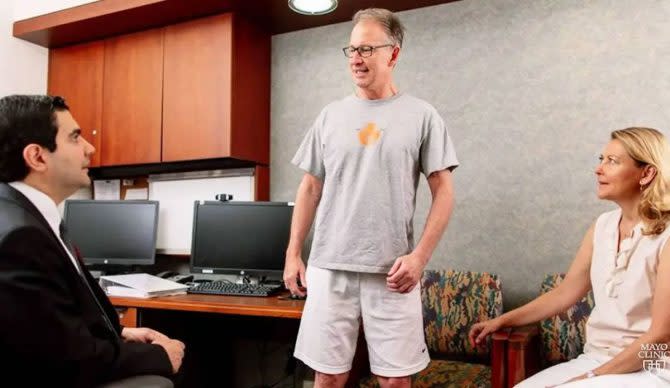Man Paralyzed In Surfing Accident Regains Ability to Walk After Stem Cell Treatment

Seven years ago, Chris Barr went surfing at San Francisco’s Ocean Beach, the same as he’d done every weekend for a decade. It began as a day like any other, but it would end with a life-changing accident. Barr walked into the water that day, but when he fell on a wave, he broke his neck in eight places. He was paralyzed from the neck down. But after a miraculous stem cell trial at the Mayo Clinic, Barr is walking again.
“He was so distraught over being paralyzed from the neck down as a result of his injuries,” wrote Joel Streed for the Mayo Clinic, “that the first thing he mouthed to his wife, Debbie, through the intubation tube when she arrived at his hospital bedside was a plea to take it all away.”
Her husband asked the impossible of her. “The first words he mouthed to me were ‘Pull the plug,’ which was so shocking,” she said.
Thankfully, Barr’s mental state improved with time. A few days later, a friend of Barr’s named Chris White — who was the one who pulled Barr out of the water on that fateful day — came to visit him. Knowing Barr was in a dark place, he had some words of encouragement.
“He said, ‘There’s technology, new developments every day,” Barr remembered. “‘Why would you throw in the towel? You’ve got nothing to lose.'”
In the weeks following his injury, Barr underwent a battery of tests, surgeries, and therapies. He improved for the first six months, but then his process flatlined. That’s when a nuerosurgeon from the Mayo Clinic named Mohamad Bydon came to see him and offered him something he couldn’t turn down: the chance to participate in a stem cell trial aimed at helping paralyzed people improve their mobility.
Stem cell treatments are still relatively new, but they show enormous promise.
“Mesenchymal stem cells taken from the stomach fat of a patient with a spinal cord injury are given time to multiply in a cultured laboratory setting,” according to the Mayo Clinic. “Then they are injected into the patient’s lower back. The cells migrate to the site of the patient’s injury and help augment healing and any initial improvement in motor and sensory function the patient might have experienced after surgery.”
Dr. Bydon emphasizes that the six-month wait is an important part of the stem cell recovery process.
“We want to intervene when the physical function has plateaued,” he said, “so that we do not allow the intervention to take credit for early improvements that occur as part of the natural history with many spinal cord injuries.”
After a few more months and consultations, Barr entered the Mayo Clinic to be patient number one in a clinical trial, including nine others, each with a variety of different spinal cord injuries. The trial tested the safety, side effects, and dosages of stem cells, and as of this writing, hasn’t been approved by the Food and Drug Administration.
But the results were, quite frankly, astonishing. Barr told ABC that the effects were immediate.
“I could feel it,” he said of the hours after his first stem cell injection. “I absolutely felt something in my legs.”
From there, Barr’s condition only continued to improve. The stem cells worked on repairing his injuries, and in the following months nearly everything got better. His scores on a grip and pinch strength test, a 10-meter walking test, and an ambulation test improved by 50 percent above his waist and 25 percent below.
Still, though, his recovery was — and still is — a long road, but the improvements Barr was seeing spurred him on. While Barr’s response to the treatment were extraordinary, Dr. Bydon knows that it wasn’t the norm.
“Although some patients like Chris are super-responders, other patients are moderate responders or nonresponders,” he said. “But this trial will help us advance the field, so we can offer new treatments for patients with spinal cord injury.”
Barr still does require a cane and a helping hand now and then to walk and go about his day-to-day business, but considering the fact that he was paralyzed from the neck down, the stem cell treatment was like a miracle.
“I can’t say it enough times that the stem-cell regimen and protocol offers hope,” he said. “The hopelessness of paralysis is just unlike anything you can imagine. And this is the hope.”
The post Man Paralyzed In Surfing Accident Regains Ability to Walk After Stem Cell Treatment first appeared on The Inertia.

